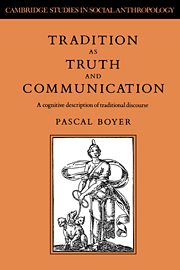Book contents
- Frontmatter
- Contents
- Preface
- Acknowledgements
- 1 Conserved world-views or salient memories?
- 2 How to think with ‘empty’ notions
- 3 Criteria of truth
- 4 Customised speech (I): truth without intentions
- 5 Customised speech (II): truth without meaning
- 6 Customised persons: initiation, competence and position
- 7 Conclusions and programme
- Notes
- Bibliography
- Index
- Cambridge Studies in Social Anthropology
5 - Customised speech (II): truth without meaning
Published online by Cambridge University Press: 27 August 2009
- Frontmatter
- Contents
- Preface
- Acknowledgements
- 1 Conserved world-views or salient memories?
- 2 How to think with ‘empty’ notions
- 3 Criteria of truth
- 4 Customised speech (I): truth without intentions
- 5 Customised speech (II): truth without meaning
- 6 Customised persons: initiation, competence and position
- 7 Conclusions and programme
- Notes
- Bibliography
- Index
- Cambridge Studies in Social Anthropology
Summary
Although traditions are commonly supposed to imply beliefs, conceptions and world views, traditional contexts are difficult to describe in these terms. More often than not, the aspects of discourse which are linked to the expression of underlying ideas and beliefs about the world are secondary or irrelevant, while the salient aspects are precisely not expressive in that sense. In chapter 2, I examined a crucial feature of the categories used in traditional interaction, namely that they are anchored to memories of singular situations rather than associated with mental definitions. As a consequence, expert utterances about these notions rely on the undefined resemblance between situations, rather than general propositions about the world. This is but an aspect of a general property of traditional discourse, which is ritualised in a variety of ways. Now, as Rappaport points out, an ‘obvious aspect’ of ritual and ritualised interaction is that they are non – discursive and non-explanatory (1914 passim).
I will now turn to a striking example of ‘non-expressivity’ in traditions, namely the use of formalised or ritualised languages. In many traditional contexts truths are supposedly contained in utterances which the listeners, sometimes even the speakers, can barely understand. The discourse itself thus constitutes an obstacle to the ‘expression’ of underlying ‘ideas’. Such phenomena cannot be just explained away as exceptions; in many societies, they are the hallmark of traditional truth. A theory of traditional discourse should therefore account for this limiting case, where truth seems to be compatible with virtually meaningless utterances.
- Type
- Chapter
- Information
- Tradition as Truth and CommunicationA Cognitive Description of Traditional Discourse, pp. 79 - 93Publisher: Cambridge University PressPrint publication year: 1990



